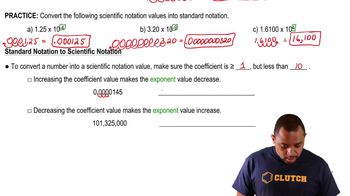Here are the essential concepts you must grasp in order to answer the question correctly.
Isotopes
Isotopes are variants of a particular chemical element that have the same number of protons but different numbers of neutrons. This difference in neutron count results in varying atomic masses. For example, Radon-220 has 86 protons and 134 neutrons, while Polonium-210 has 84 protons and 126 neutrons. Isotopes can be stable or radioactive, influencing their applications in fields like medicine and archaeology.
Recommended video:
Nuclear Notation
Nuclear notation is a way of representing isotopes using the element's symbol along with its mass number and atomic number. The mass number, which is the sum of protons and neutrons, is written as a superscript to the left of the element symbol, while the atomic number is written as a subscript. For instance, Radon-220 is denoted as ²²⁰Rn, where 220 is the mass number and 86 is the atomic number.
Recommended video:
Standard Notation to Scientific Notation
Element Symbols
Element symbols are one- or two-letter abbreviations used to represent chemical elements on the periodic table. Each symbol is unique to an element and often derived from its English or Latin name. For example, Gold is represented as 'Au' from its Latin name 'Aurum'. Understanding these symbols is essential for writing chemical formulas and representing isotopes accurately.
Recommended video:
 Verified step by step guidance
Verified step by step guidance

